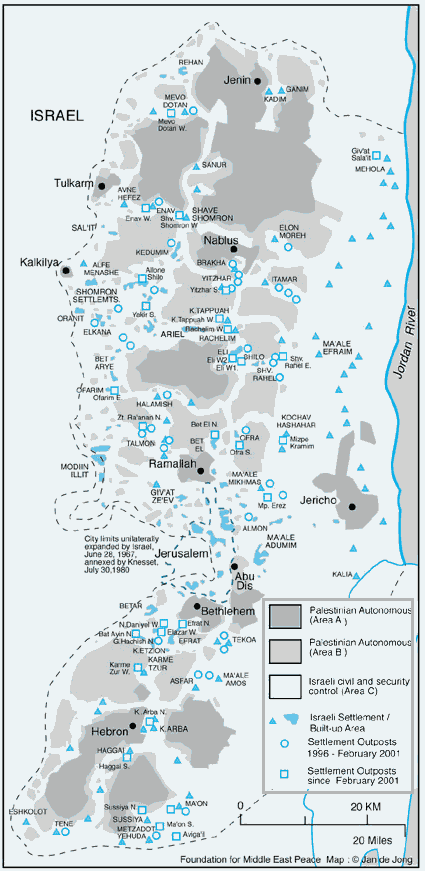UPDATES
How much land do West Bank settlements take up?
November 18, 2011 | Tzvi Fleischer

A constant talking point on the Middle East is that Israeli building in settlements in the West Bank is supposedly taking up more and more land and supposedly making Palestinian statehood unviable. A typical example summarising this “conventional wisdom” was the claim cited in the Age last week by veteran Australian diplomat Richard Woolcott (Nov. 11).:
Middle Eastern diplomats outside Israel have depicted the present situation as like two people arguing over a pizza, but before the argument is resolved one side (Israel through the acceleration of its settlements program) has started to eat the pizza.
An even more direct enunciation of this claim came from Sydney Morning Herald chief correspondent Paul McGeough earlier this year:
it has not mattered which Israeli party or coalition has been in government, whether a Republican or a Democrat is in the White House, wherever the Israeli peace movement or the military is ascendant; whether there is a cold peace or a hot war, an intifada or an Oslo peace process; whether Hamas is on top of Fatah or the reverse, or whether the talk is of a one-state or a two-state solution … Israel has continued to gobble up Palestinian land and the postage stamp that might be Palestine gets smaller and smaller.
Now, as AIJAC has repeatedly pointed out in the past, this argument makes no sense, because Israel has had in place since 2003 arrangements that it negotiated with the Bush Administration in Washington that no new West Bank settlements can be built and existing settlements cannot expand territorially. Any construction in them is only in built up areas. As then Israeli Prime Minister Ariel Sharon said in a major policy speech in December 2003:
Israel will meet all its obligations with regard to construction in the settlements. There will be no construction beyond the existing construction line, no expropriation of land for construction, no special economic incentives and no construction of new settlements.
More on these arrangements comes from Elliot Abrams, the US National Security Council official who largely negotiated them with his Israeli counter-parts.
And these arrangements remain in place to do this day. (If anyone needs to see proof that Israel has not built any new West Bank settlements – none have been built with govenment approval, though some settler groups have constructed “outposts” in violation of Israeli law – since 1998, see this list of settlements and their construction dates from the Foundation for Middle East Peace, a Washington thinktank generally highly critical of Israel’s settlement policy.)
But perhaps the fact that Israel is not taking any additional land to expand West Bank settlements doesn’t matter – perhaps the damage is done, and too much West Bank land is already covered by settlements to allow a Palestinian state to be “viable” as is often claimed?
So how much of the West Bank is covered by settlements?
At most 2%, but probably more like 1%.
Don’t believe me? I’ll prove it by using only sources which cannot be accused of being likely to fudge figures in Israel’s favour.
Let’s start with the BBC. The BBC published a series of maps as part of a fact sheet called “Israelis and Palestinian in depth”. Of the West Bank it says:
Since 1967, Israel has pursued a policy of building settlements on the West Bank. These cover about 2% of the area of the West Bank and are linked by Israeli-controlled roads…
But that number is probably too high. This is clear from some work done by the well-known Israeli NGO B’tselem. B’tselem is highly critical of Israeli settlement policy in the West Bank, and commissioned a detailed survey of the West Bank to determine the degree of settlement control and published a highly critical report last year. The group choose to focus their publicity for the report on the fact that municipal and regional councils associated with the settlements had theoretical legal jurisdiction over 42% of the West Bank, but they also conceded that their survey showed that the “built-up area” of settlements constituted a mere .99% of West Bank land. (As for the 42% number, one often quoted by Palestinian advocates, it is pretty irrelevant. This is municipal jurisdiction – ie zoning, planning, responsibility for local road maintenance – over mostly empty land. This land can become part of a future Palestinian state essentially at the stroke of a pen.)
As an American CBS News story about the B’tselem report noted,
Although the actual buildings of the settlements cover just 1 percent of the West Bank’s land area, their jurisdiction and regional councils extends to more than 42 percent, the group added.
And then there’s what the Palestinians themselves say on the subject. Just a few weeks ago, veteran Palestinian negotiator Saeb Erekat gave an interview with the Arabic radio station As-Shams about the 2008 negotiations with the Olmert government, and agreed that the settlements were approximately 1.1% of the West Bank. According to the left-leaning Israeli daily Haaretz
Erekat stated furthermore that despite Israel’s continual policy of “occupation and settlement building,” an aerial photograph provided by European sources shows that settlements have been built on approximately 1.1% of the West Bank…
The above was highlighted by veteran Israeli columnist Evelyn Gordon, who also noted a very interesting recent quote from former Obama Administration Middle East mediator George Mitchell concerning the Palestinian demand for a complete settlement freeze before negotiations can re-commence.
Commenting on the 10-month moratorium on most new building in settlements put in place by the Netanyahu government in 2009-2010, Mitchell noted:
The Palestinians opposed it on the grounds, in their words, that it was worse than useless. So they refused to enter into the negotiations until nine months of the ten had elapsed. Once they entered, they then said it was indispensable. What had been worse than useless a few months before then became indispensable and they said they would not remain in the talks unless that indispensable element were extended.
Mitchell, I think it is fair to say, is generally regarded as having been pretty sympathetic to Palestinian demands vis a vis settlements. Yet here he is strongly implying that Palestinian obsession with halting construction in settlements seemed to be little more than a negotiating ploy, a tactical game.
Given the above, I am hoping that fewer intelligent and well-meaning people, interested in finding a genuine two state Israeli-Palestinian resolution will say stupid and ill-informed things about settlements.
Of course, just because settlements are not growing in terms of area, and they take up less, probably much less, than 2% of the West Bank does not mean they are not an issue in the peace talks and process at all, nor that there is never reasonable grounds for criticising Israeli settlement policies. And of course, infrastructure such as roads necessary to support settlements does take up additional West Bank land which will need to be annexed to Israel in exchange for land swaps in any future peace deal (On land swaps, David Makovsky’s Washington Institute study from last year, “Imagining the Border” still provides the definitive guide to how they could be done.)
But the issue is vastly overblown in many forums, where it is taken for granted that the settlements are proof positive of Israeli ill-will and responsibility for the perpetuation of the conflict, as well as justifying abandoning hopes for a two state resolution. I am hoping that the facts above provide the basis for a little bit of perspective on the issue, though given the emotion, passion, and sheer bloody-mindedness that often adheres to discussion and debate about the Middle East, I probably shouldn’t hold my breath.
Tzvi Fleischer
Tags: Israel





